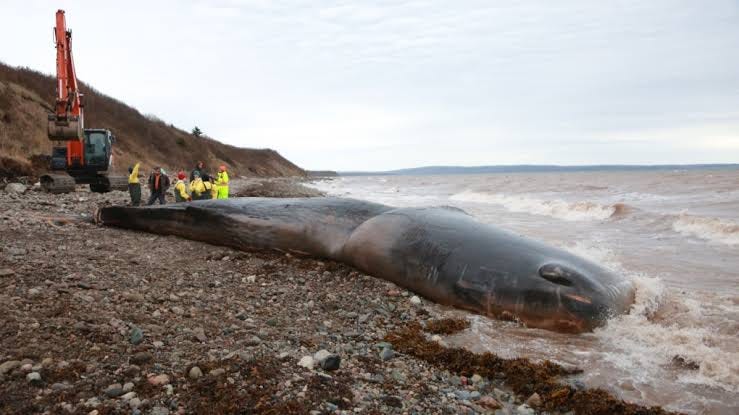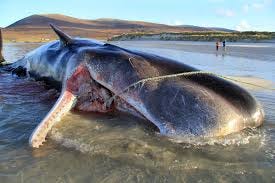Whales dying from consuming plastics
Blame Coca-Cola and PepsiCo, the world’s worst plastic polluters, according to a new study
The dead whale, Credit, CTV News Atlantic
Researchers made an upsetting discovery in the belly of a whale in Nova Scotia a few days ago. In the subsequent report, 330 pounds of garbage lodged in the stomach of the animal, leading to the death of the 40-foot male, as the massive ingestion of fishing gear and plastics caused emaciation and consequent stranding of the giant fish.
A few days before the report, Break Free from Plastic (BFFP) released its annual report for 2022, collated through 14,760 volunteers in 597 brand audits across 44 countries, collecting 429,994 pieces of plastic waste in the process, participants documenting brands from 4,645 parent companies. In the report, BFFP named Coca-Cola, PepsiCo, Nestle, Unilever, and others as the world’s worst plastic polluters.
The same conclusion emerged in the previous year’s report, where 11,184 BFFP volunteers conducted 440 brand audits across 45 countries, collecting 330,493 pieces of plastic waste, 58% of which was marked with a clear consumer brand. Just as in the case this year, Coca-Cola, PepsiCo, Nestle, Unilever, and others ended as the world’s worst plastic polluters.
Unfortunately, as the world’s worst plastic polluters, Coca-Cola and her allies cause animals such as the Nova Scotia whale to get ingested with fishing gears and plastics, dying ultimately from the occurrence. Before dying, the marine animals undergo emaciation, then starvation, unable to eat from the mass of fishing gear, plastics, and other garbage lodged in their stomach.
In 2022, 31,000 branded products of plastic waste, representing 63% from 2021, emerged out of BFFP’s audit, with the exercise finding more and more Coca-Cola plastic products each year. As for Coca-Cola, it produces three million tons of plastic packaging a year, an equivalent to 200,000 bottles a minute, and when its packaging footprint gets translated into plastic bottles, they amount to 108 billion bottles a year, more than a fifth of the world’s total of around 500 billion bottles a year.
Nestle burns an estimated 95,000 plastic wastes every year across China, India, the Philippines, Brazil, Mexico and Nigeria, with the burnt waste large enough to cover more than 15 football fields a day. Philippines occupies the first position as the company’s biggest polluter among the six countries monitored, having 35,500 metric tons of plastic produced in it each year, followed by Brazil, Nestle’s third largest market in terms of sales.
PepsiCo burns or dumps 137,000 metric tons of plastic each among the countries, more than enough waste to cover 22 football fields a day, with Mexico producing the company’s biggest pollution footprint, having approximately 39,500 metric tons produced.
With Coca-Cola and her allies producing so much plastic, eight million tons of plastics every year end up in the ocean, eaten by whales from Nova Scotia and other places, causing their destruction. Football fields alone don’t suffer the impacts of the plastic pollution, and the Nova Scotia whales aren’t the only victims, as the hundreds of thousands pieces of plastic waste bring other repercussions, as bad as the pollution of football fields and the death of the Nova Scotia sperm whale.
For instance, more than one million marine animals die every year from plastic materials in the ocean, and researchers say 60 billion pounds of plastic get produced each year, increasing the buildup of the waste over an estimated five million square miles, an equivalent to the area of U.S. and India combined.
Plastics kill one million sea birds annually, as leakages into the environment double to 44 million tons a year, while the buildup of plastics in lakes, rivers, and oceans come at more than triple quantities, with plastic waste projected to balloon in developing and emerging economies in Asia, Latin America, and Africa.
Numerous sea turtles die every year from digesting plastic wastes, with a turtle having a 22% chance of perishing from ingesting one plastic item, the mortality rate jumping to a 50% chance if a turtle gobbles 14 pieces of plastic. Added to this, 54% of post-hatching turtle, and 23% of juvenile turtles harbors plastics inside of them compared to 16% of adult turtles.
The situation with the turtles could worsen in the following years, as an Organization for Economic Cooperation and Development (OECD) report estimates the global plastic consumption to rise from 460 million tons in 2019 to 1,231 million tons in 2060 with the absence of bad policies. The absence of bad policies will also affect whales, sharks, sea birds, and mammals in the near future, since they will have to cope with both micro plastics and macro plastics in oceans.
To survive a future plagued with micro plastics and macro plastics, as well as spare the lives of animals, governments must hold Coca-Cola, PepsiCo, Nestle, and the others to be accountable for their plastic actions. A united global reaction to the operations of these corporations becomes necessary, to stop the leakage of plastics into the ocean. If the leakages from Coca-Cola and the others continue at the present rate, more of the Nova Scotia whale can die from plastic pollution in the near and long term.
Further Reading
Dead whale, Credit, New York Times
Whales and the plastics problem. Read More.
A quantitative analysis linking sea turtle mortality and plastic debris ingestion. Read More.
5 - Plastic impact on sharks and rays. Read More.
Plastic Pollution Affects Sea Life Throughout the Ocean. Read More.
What to Eat
Vegan sea food, Credit, Forbes







It unnerves me, and I know it unnerves many people, what happened at COP27, when the biggest polluters were the official sponsors. It unnerves me, because it means the world isn't serious about tackling climate change, as the biggest polluters shouldn't be allowed to have anything to do with any event meant to tackle climate change.
Weldon Adetokunbo!